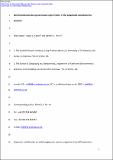Biomineralisation during operculum regeneration in the polychaete Spirobranchus lamarcki
Abstract
Formation of calcified biominerals is widespread in marine animals and is often associated with important elements of their biology, such as support and protection. Serpulid polychaetes are relatively understudied examples of biomineralisation despite their prominence in many marine ecosystems. An investigation of calcification in the regenerating opercular plate of the serpulid polychaete Spirobranchus (formerly Pomatoceros) lamarcki was performed using optical microscopy, calcein labelling and powder diffraction analysis. Worms were collected between January 2012 and June 2013 from East Sands beach, St Andrews, Scotland (56.33° N, 2.78° W). The earliest visible signs of calcification were birefringent grains. Later-stage regenerates displayed a complex mixture of calcified structures including grains, round, smooth tiles, and larger tiles with a rugged appearance. The plate matures by the growth and eventual merging of tiles into a contiguous crust. Calcein pulse-chase experiments showed the progression of calcification from the centre towards the edge of the plate, and powder diffraction analysis of three regenerative stages revealed a major shift in mineralogy from a predominantly calcitic to a predominantly aragonitic composition. The mechanisms underlying the shift are currently unknown. These are the first mineralogical data comparing different developmental stages in a serpulid operculum, and contribute to the understanding of biomineralisation in this group.
Citation
Szabo , R , Calder , A & Ferrier , D E K 2014 , ' Biomineralisation during operculum regeneration in the polychaete Spirobranchus lamarcki ' , Marine Biology , vol. 161 , no. 11 , pp. 2621-2629 . https://doi.org/10.1007/s00227-014-2534-3
Publication
Marine Biology
Status
Peer reviewed
ISSN
0025-3162Type
Journal article
Description
RS was supported by a Carnegie Scholarship.Collections
Items in the St Andrews Research Repository are protected by copyright, with all rights reserved, unless otherwise indicated.

